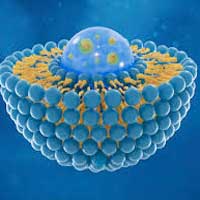 Cutting-edge microscope helps reveal ways to control the electronic properties of atomically thin materials.
Cutting-edge microscope helps reveal ways to control the electronic properties of atomically thin materials.
Friday, February 26, 2021
Engineering the boundary between 2D and 3D materials
 Cutting-edge microscope helps reveal ways to control the electronic properties of atomically thin materials.
Cutting-edge microscope helps reveal ways to control the electronic properties of atomically thin materials.
Light-emitting tattoo engineered for the first time
 Researchers have created a temporary tattoo with light-emitting technology used in TV and smartphone screens, paving the way for a new type of 'smart tattoo'.
Researchers have created a temporary tattoo with light-emitting technology used in TV and smartphone screens, paving the way for a new type of 'smart tattoo'.
Sub-diffraction optical writing enables data storage at the nanoscale
 Researchers have overcome the limitation of laser-enabled optical data storage by using earth-rich lanthanide-doped upconversion nanoparticles and graphene oxide flakes.
Researchers have overcome the limitation of laser-enabled optical data storage by using earth-rich lanthanide-doped upconversion nanoparticles and graphene oxide flakes.
From microsaws to nanodrills: laser pulses act as subtle machining tools
 Industrial-grade materials processing on the sub-micron scale is enabled by spatially structured ultrashort laser pulses.
Industrial-grade materials processing on the sub-micron scale is enabled by spatially structured ultrashort laser pulses.
A more effective nanomedicine developed for the treatment of rare Fabry disease
 The results have been made possible thanks to nanotechnology and the approach developed could be applied to other drugs in the future. The new drug improves on current treatments, helps reduce costs and improve patients' quality of life.
The results have been made possible thanks to nanotechnology and the approach developed could be applied to other drugs in the future. The new drug improves on current treatments, helps reduce costs and improve patients' quality of life.
Physicists develop a new method for counting molecules
 Picosecond time-resolved photon antibunching measures nanoscale exciton motion and the true number of chromophores.
Picosecond time-resolved photon antibunching measures nanoscale exciton motion and the true number of chromophores.
Weakness is strength for this low-temperature battery
 Nanoengineers have discovered new fundamental insights for developing lithium metal batteries that perform well at ultra-low temperatures; mainly, that the weaker the electrolyte holds on to lithium ions, the better.
Nanoengineers have discovered new fundamental insights for developing lithium metal batteries that perform well at ultra-low temperatures; mainly, that the weaker the electrolyte holds on to lithium ions, the better.
Sustainable harvesting of electrical energy with nanoporous materials
 Scientists are investigating whether phase transitions of water in nanopores can be used to generate electrical energy on a larger scale.
Scientists are investigating whether phase transitions of water in nanopores can be used to generate electrical energy on a larger scale.
Adding nanofibers to the silkworm's diet makes them spin stronger silk
 Researchers tweaked the diet of silkworms by adding cellulose nanofiber to their food. The resultant silk was stronger and more durable. This new method of realizing cellulose nanofiber synthesized silk is a sustainable way to produce biomaterials.
Researchers tweaked the diet of silkworms by adding cellulose nanofiber to their food. The resultant silk was stronger and more durable. This new method of realizing cellulose nanofiber synthesized silk is a sustainable way to produce biomaterials.
Subscribe to:
Posts (Atom)
